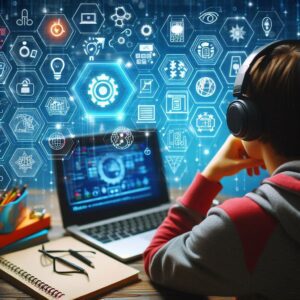The integration of technology in education is reshaping how we teach and learn. This article explores the impact of this trend and how it’s paving the way for a more interactive and personalized educational experience.
Revolutionizing Learning with Technology in Education
Interactive Learning Through Educational Technology
The advent of technology in educational settings has introduced a myriad of interactive tools, fundamentally changing the way students engage with content. Smart boards and educational apps are prime examples, offering diverse and adaptive learning experiences.
Smart Boards
These interactive displays have become central to the modern classroom, allowing teachers to bring lessons to life with multimedia presentations that students can interact with.
Educational Apps
Apps such as Duolingo and Khan Academy personalize the learning journey, providing interactive exercises tailored to individual learning styles.
Expanding Horizons with Technology in Education
The global landscape of education is being reshaped by technology, enabling connections that span across continents and cultures, thus creating a rich, diverse learning environment.
E-Learning Platforms
Platforms like Coursera have democratized education, allowing students from remote areas to access world-class resources and instruction.
Success Stories Worldwide
From India’s e-learning initiatives to Africa’s virtual universities, technology is breaking down barriers and fostering educational inclusivity on a global scale. The Brookings Institution’s studies provide further evidence of how education technology can improve learning outcomes globally, making them a valuable resource for readers seeking more information.
Personalized Education Through Technology
Customized Learning Paths with Educational Technology
Adaptive learning systems exemplify the transformative power of technology in education. These systems use sophisticated algorithms to analyze students’ performance in real-time, adjusting the curriculum to fit each student’s unique learning needs. The implementation of adaptive learning technologies involves integrating them into the classroom through various platforms, such as learning management systems (LMS) that support adaptive courses and modules.
The benefits of adaptive learning technologies are manifold. They provide a personalized learning experience that can accommodate different learning speeds and styles, ensuring that each student can learn in a way that is best suited to them. This leads to improved engagement, as students feel their individual needs are being met, and it can also result in better academic outcomes because the material is presented in a way that is more accessible to them.
Insights and Analytics in Educational Technology
Data analytics in education is a game-changer, offering deep insights into student learning patterns and outcomes. By collecting and analyzing data from various sources, including LMS, educators can gain a comprehensive understanding of student performance. This data can reveal trends and pinpoint areas where students may be struggling, allowing for timely intervention.
The impact of data analytics on student outcomes is significant. Schools and educators can use this information to tailor instruction, provide additional resources where needed, and even predict which students may need extra support to succeed. This proactive approach can lead to improved academic performance, higher retention rates, and a more personalized education experience that can adapt to the evolving needs of students.
Preparing Students for a Technological Future
Skill-Building with Technology in Education
In today’s digital era, the education system is prioritizing a set of core skills to ensure students are well-equipped for the future workforce. These include:
- Computer Skills: Basic computer literacy is foundational, encompassing the ability to operate software, understand hardware, and navigate the internet.
- Coding: Understanding programming languages and the ability to solve problems through code is increasingly valuable.

- Data Science and Analytics: The ability to analyze and interpret data is crucial in a data-driven world.
- Digital Marketing: Skills in online marketing and social media are essential for many business-related careers.
- UX/UI Design: Designing user-friendly interfaces is important for technology products.
Technology in education aids the development of these skills through various platforms and tools that provide practical, hands-on experience. For example, coding can be taught using educational websites that offer interactive coding exercises, while data analytics can be introduced through software that allows students to work with real datasets.
Educator’s Guide to Technology in Education
The role of educators is pivotal in the successful integration of technology in the classroom. Continuous professional development is essential for teachers to stay current with technological advancements and to effectively incorporate them into their teaching methods. This includes understanding how to use educational software, manage learning management systems, and provide technical support to students and teachers.
Professional development opportunities can help educators develop the skills necessary to implement e-learning and utilize instructional technology effectively. By staying updated with the latest technological tools and pedagogical strategies, educators can enhance student learning outcomes and prepare them for the challenges of the future.
Overcoming Obstacles in Technology-Driven Education
Addressing the Digital Divide in Educational Technology
The digital divide poses a significant challenge in technology-driven education, as it creates disparities in access to digital tools and internet connectivity. This divide affects students’ ability to participate in digital learning and limits their educational opportunities.
Challenges of the Digital Divide
- Access to Devices: Students from low-income families may not have personal computers or tablets at home.
- Internet Connectivity: Many areas, especially rural and underserved communities, lack reliable high-speed internet.
- Digital Literacy: Even with access to technology, some students and educators may lack the necessary skills to use it effectively.
Solutions Being Implemented
- Infrastructure Investment: Governments and organizations are investing in infrastructure to improve internet connectivity in underserved areas.
- Device Distribution Programs: Schools and non-profits are providing laptops and tablets to students who need them.
- Digital Literacy Initiatives: Educational programs are being developed to teach students and teachers how to use technology effectively.
Safeguarding Data with Technology in Education
As educational institutions increasingly rely on technology, the importance of cybersecurity cannot be overstated. Protecting sensitive student information is paramount to maintaining trust and ensuring the safety of the educational environment.
Importance of Cybersecurity
- Data Protection: Schools store sensitive data, including personal information, academic records, and health details.
- Preventing Cyber Threats: Educational institutions are targets for cyberattacks, which can lead to data breaches and loss of privacy.
- Compliance with Regulations: Schools must comply with data protection laws and regulations.
Measures for Data Protection
- Cybersecurity Training: Educating staff and students on best practices for data security.
- Implementing Security Protocols: Using firewalls, antivirus software, and secure networks to protect against unauthorized access.
- Regular Audits and Updates: Ensuring that security systems are up-to-date and conducting regular audits to identify potential vulnerabilities.
Conclusion
Technology in education has revolutionized learning, making it more interactive, personalized, and accessible. Interactive tools and global connectivity have broken down barriers, while adaptive learning and data analytics have tailored education to individual needs.
Looking ahead, technology will continue to evolve, further personalizing learning experiences and expanding educational boundaries. The future promises even greater integration of artificial intelligence (AI) and machine learning, offering students an education that’s more responsive and immersive than ever before.


